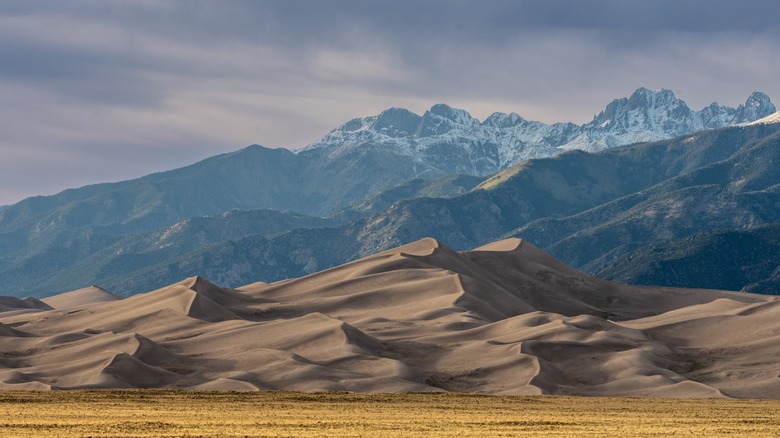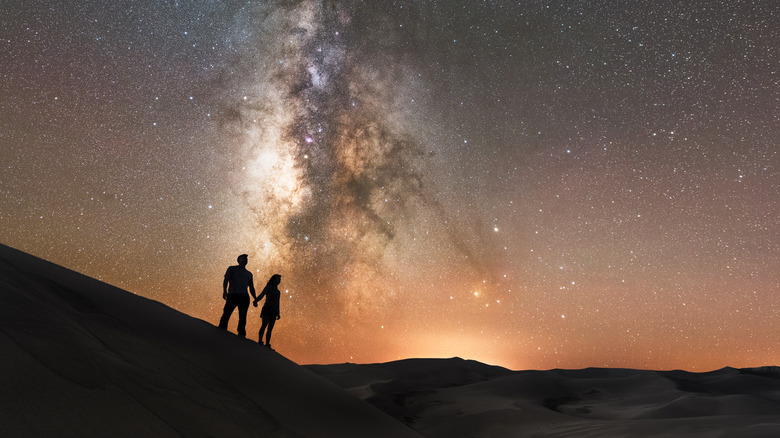If you have recently been captivated by the sprawling deserts of Denis Villeneuve’s “Dune,” you may feel drawn to the closest equivalent to the film’s mesmerizing spice fields: Great Sand Dunes National Park. However, it’s important to temper your enthusiasm with a dose of reality: Exploring these incredible sand dunes is a challenging adventure, and not everyone can embody the resilience and agility of Timothée Chalamet’s character.
Great Sand Dunes National Park, spanning over 225 square miles in southern Colorado, is home to North America’s tallest and broadest dunes. Among these, the Star Dune stands out, reaching a height of 750 feet from its base to its peak, making it the tallest dune in sheer elevation. On the other hand, High Dune appears taller from a distance because it starts from a higher elevation, but it measures 699 feet in height from its base to its peak. Regardless, they’re both gigantic mounds of sand, and although challenging, the High and Star Dune Loop Trail gives way to the most rewarding hiking experience. Tackling this hike is the best way to appreciate its gratifying views while finding your spice.
Traversing the sandy expanse, you’ll be continually amazed by the diverse, otherworldly landscape, with the stunning Sangre de Cristo Mountains and the prominent 13,347-foot summit of Mount Herard as your backdrop. As you follow the trail, you’ll come across Medano Creek, a tranquil oasis that houses Rio Grande cutthroat trout, offering an ideal spot for a quick catch-and-release fishing break amidst the scenic beauty.
What makes the High and Star Dune Loop so difficult?

The High and Star Dune Loop, an 8-mile trail featuring an elevation gain of 1,310 feet, might initially appear manageable, requiring at least six hours to complete. However, numerous factors transform what could be a straightforward hike into a significantly challenging endeavor. Walking on steep, sandy slopes is inherently more demanding than a solid trail. Michael Bozzella puts it bluntly in a review on AllTrails, “Think stair master on ‘eternal damnation’ setting at some parts.”
For many visitors, the challenges encountered are inevitable due to the nature of the environment. As this is a sand dune park, trails are not defined. So follow your map, but don’t be afraid to carve your unique path. Second, the only respite from the sun’s rays comes from occasional cloud cover, offering minimal protection against the sun’s intensity. This heat isn’t just from above; the sand below can become extremely hot, too, putting you in a literal heat sandwich. To avoid the discomfort of blistering sand (especially if hiking barefoot), it’s advisable to start the hike early in the day. During summer, sand surface temperatures can reach 150 degrees Fahrenheit.
Hikers should be particularly cautious of the altitude sickness if they are not acclimated to the lower oxygen levels. Additionally, the open dunes are known for their rapidly changing weather conditions, including high winds that can carry sand, significantly reducing visibility and adding to the challenge of the hike, along with the potential for some stormy lightning.
Tips for the hike

Do you still want some of that “Dune” spice? Of course you do! Accessing the Great Sand Dunes National Park is straightforward: Drive from the south and take US 160 to CO 150, or drive from the west and take CO 17 to Lane 6 and then onto CO 150. The park, located north of CO 150, welcomes visitors 24/7 throughout the year. Entrance fees for private vehicles are $25, and for those planning multiple visits, an annual park pass is available for $45. Tip: Always check the park’s website for any travel advisories or route changes.
Before you show up, you should definitely gear up for the adventure. Pack water (more than you think you’ll need), food rich in energy, and sun protection. If you plan on camping anywhere within the park, do not forget a flashlight, as there are no outdoor lights (this makes for sublime night sky views). Camping supplies (that you can buy at IKEA) and a portable charger are a must. If you’re feeling adventurous, don’t forget sandboards or sleds. It’ll make going down those slopes much easier and more fun.
Cellular service may be spotty, and there is no Wi-Fi in the park — so download all trail maps for offline use. Although not on this trail specifically, it’s worth noting that black bears and mountain lions are active at night in the park’s greener areas. It’s advised to report any sightings to park rangers, especially if you see one of Dune’s colossal sandworms!

